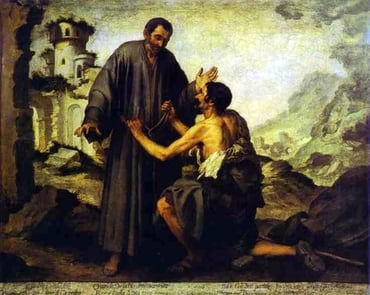Arcana Coelestia # 3210
3210. 'And Isaac brought her into the tent of Sarah his mother' means the sanctuary of truth within the Divine Human. This is clear from the meaning of 'a tent' as that which is holy, dealt with in 414, 1102, 2145, 2152, 2576, and so the sanctuary; and from meaning of 'Sarah his mother' as Divine truth, dealt with in 1468, 1901, 2063, 2065, 2904, from which the Divine Human was born, the Rational of which is represented by 'the son Isaac'. From this it is evident that 'Isaac brought her into the tent of Sarah his mother' means that rational Good guided Truth represented by Rebekah into the sanctuary of truth. What the sanctuary of truth is becomes clear from what has been stated above in 3194 about the Lord's Divine Human - that Good and Truth belong essentially to the Divine itself, but that the Lord's Divine Human came into existence from Divine Good and was born (as to the Divine itself, that is) from Divine Truth; or what amounts to the same, that the Lord's Essential Being (Esse) was Divine Good, but the Manifestation (Existere) of Him was Divine Truth. From this came Divine Rational Good to which He joined Divine Truth from the Human.
[2] It is impossible to say anything more about this very deep arcanum than this: Divine Good and Truth themselves within the Lord's Divine Human to which Truth from the Human was joined are what were meant by the Sanctuary or Holy of Holies in the Tabernacle and in the Temple. The nature of that Good and Truth was represented by the objects within the Sanctuary, such as the golden altar, the table with the loaves of the presence, and the lampstand; and further within, by the Mercy Seat and the Ark; and within it, inmostly, by the Testimony which was the Law delivered from Sinai. This was the Holy of Holies itself or Sanctuary of Truth.
Mercy

In regular language, "mercy" means being caring and compassionate toward people in poor states. That's a position we are all in relative to the Lord, all the time. Without Him we would be unable to choose what is good; without Him we would be unable to formulate a reasonable thought. Without Him, in fact, we would instantly cease to exist; we have life only because He constantly gives us life. So we are, quite literally, at His mercy. Fortunately, the Lord is caring and compassionate to a degree we cannot fathom. He is the source of all caring and all compassion, and of love itself. His mercy toward us never lessens, never abates, never ends; His whole purpose is to bring each of us, individually, to heaven. The meaning of "mercy" in the Bible is closely tied to this idea: it represents love in a general sense, and the desire for good that comes from love. It can also represent the desire for good and the ideas that describe it when those thoughts and desires are inspired by love of the Lord.






